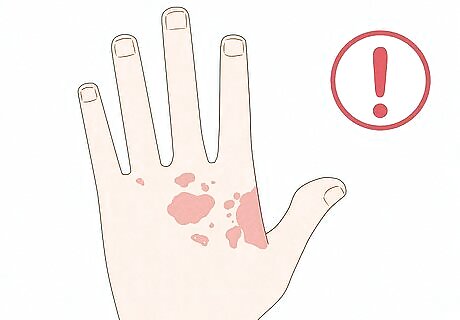
views
- The simplest way to remove epoxy resin from your skin is by washing your hands with soap and warm water.
- Household items like vinegar, baking soda, and rubbing alcohol can also be used to remove resin.
- There are many commercial solvents, like hand gel cleansers, that are safe to use on skin and can dissolve resin.
How to Get Resin Off Your Hands

Soap and water: Soak your hands in warm water until the resin softens. Then, apply some liquid soap and rub your hands together. This should loosen the bond between the epoxy and your skin. If there is still some residue left, use a cloth to scrub the remaining resin from your hands. Vinegar: Apply vinegar to a cotton ball or the corner of a rag, then gently scrub the area the resin is stuck to. The vinegar will dissolve the resin. Follow up with a moisturizer to protect the skin on your hands. Citrus cleaner: Since citrus is acidic, it’s great at dissolving resin. Dilute a citrus-based cleaner with some warm water and apply it to the affected area. This should soften the epoxy so you can easily peel or scrape it off. Another option is to use a citrus-infused soap, which you can buy at most health and wellness stores. Sugar scrub: Making a sugar scrub may take a little more effort than just soap and water, but sugar scrubs are another option for removing resin from your skin. Mix 2 cups of sugar, half a cup of oil, and a few drops of essential oils. Rub the mixture onto the affected area until the resin loosens. Put any excess scrub into a sealed container to use in future incidents. Acetone: In a well-ventilated area, soak a cotton ball in acetone and dab it onto the resin until it loosens. Make sure to wash your hands thoroughly once the resin has been completely removed. Baking soda: Baking soda can be used for almost anything – including removing resin from your hands. Pour plain baking soda into your dry hands, and then add some dish soap. Mix them and scrub your hands together. The epoxy should dissolve, and then you can wash your hands with water. Hand sanitizer: While this is not one of the stronger methods, hand sanitizer can remove resin from stubborn areas. Rub the sanitizer into your skin until the resin starts to come off. This could take some time, so this might not be the best method if you’re in a hurry. Petroleum jelly: Coat your hands in a thin layer of petroleum jelly. Lightly rub it into your skin and let it sit for a few minutes. Use a washcloth to wipe off excess residue, and repeat as needed until the resin is gone. Rubbing alcohol: Alcohol is an organic solvent, so rub it on your hands to remove any leftover epoxy. It can quickly dry out your hands, however, so be careful! Make sure to apply a moisturizer after rinsing your hands. Commercial solvent: If none of the home remedies are working, a commercial solvent might be your best bet. Resin solvents are made to remove any sticky residue, and they won’t cause extra damage to your skin. Plus, they can remove the smell of resin, too! Just read the instructions to know how long to leave it on your hands before washing it off.
What happens if you get resin on your hands?

Resin may cause eczema and allergic reactions. Epoxy resin is an irritant that causes your skin to become red and itchy. In some cases, direct contact with resin can cause skin conditions like eczema. It’s best to remove resin as quickly as possible when it gets on your skin., just to be safe. Some resins can be toxic. Do your research when choosing the best and safest resin to work with.
How to Prevent Contact with Resin

Wear gloves. Always wear a pair of nitrile gloves when working with resin. Should any spills or accidents happen, this will help keep resin off your hands. Wear goggles. It’s also important to protect your eyes and face while working with epoxy. Wearing goggles helps prevent resin from sticking to the sensitive skin on your face and keeps harmful particles from getting in your eyes. Wear an apron and long sleeves. Your hands aren’t the only place resin can stick to. Protect your arms and body by wearing long sleeves and an apron. This way, if resin splashes or spills, your skin is covered.



















Comments
0 comment